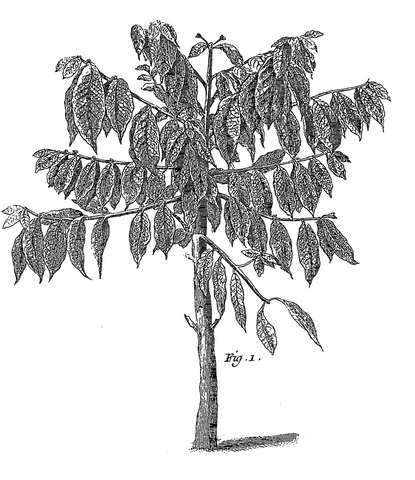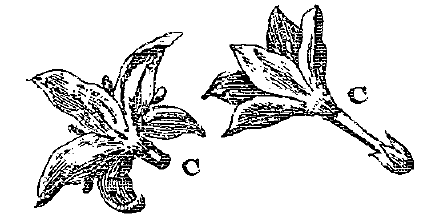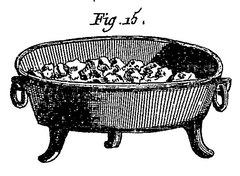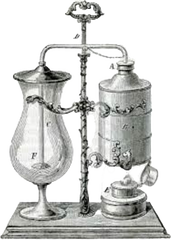What is coffee?
What we commonly call coffee is the stimulating hot drink consumed daily by a very large part of the world's population, we're not telling you anything new.
The fact that this dark-hued beverage comes from ground coffee beans mixed with water shouldn't come as a revelation to you either. However, what is generally less known is the botanical aspect of coffee and its processing.
Coffee botany - nf

Coffee beans come from the coffee plant, a shrub that grows between 2 and 12 meters tall, depending on the variety. This subtropical or tropical shrub with large leaves thrives in partial shade and grows naturally in certain forests between the Tropics of Cancer and Capricorn. Coffee plants grow at altitudes ranging from 600 to 2400 meters and can withstand temperatures between 15 and 30°C.
Whether in the lush forests of Ethiopia, on the slopes of volcanoes in Guatemala or in the humid microclimates of Colombia, coffee adapts and reveals its uniqueness depending on its growing location, its botanical varieties , the fermentation methods applied and the know-how of the producers throughout the process.
Coffee production - nf

It all starts with a seed. It takes three to five years for the tree to bear its first fruit and be ready for harvest. The tree's life cycle is then dictated by the dry and wet seasons, from flowering, which can last between six and nine months, to harvest time. The fruit, called a "coffee cherry," resembles the cherries that grow in France. They are edible and change color over time: green, then yellow, and finally red when fully ripe.

Next, they are harvested and begin a fermentation and drying process that producers have mastered to perfection in order to extract the "kernel": the two coffee beans that interest us. These beans are green/yellow and rather soft; it is possible to bite into them, revealing rather unappealing vegetal aromas (chickpea, asparagus, etc.).
Then the grains are cleaned, sorted and bagged for export to all corners of the world, including the Celsius workshop.
Coffee roasting - nf
It is only once heated that these green grains reveal their true potential.

They are roasted using a roaster, a machine that roasts the coffee (yes, it's the same word used for the profession of coffee roaster, sometimes leading to confusion). To put it simply, this roaster is a cross between a barbecue and a washing machine that allows for gradual and even roasting.
Roasting allows the sugars naturally present in green coffee beans to caramelize through the Maillard reaction and release their water through evaporation. Heated to over 200°C for 8 to 14 minutes, the green beans take on their characteristic brown color. ( More details on roasting) When properly controlled, roasting acts as a true flavor enhancer, much like winemaking for grapes. Depending on the roasting process, it can accentuate certain characteristics more than others, resulting in a more pronounced acidity or, conversely, a sweeter cup of coffee. The same is true for aromas, which can vary considerably depending on the roasting parameters.
When roasted, coffee has no less than 800 different aromas (compared to 400 in wine).
Coffee extraction - nf

Finally, after a few days of resting, the coffee will be ready to drink. But beware, extraction is the last crucial step in this long process from bean to cup. It's responsible for extracting the precise amount of aromatic components from the coffee to achieve perfect balance. It can elevate the work of the producers and roasters, or conversely, destroy their efforts if it isn't done correctly.
Indeed, unlike a bottle of wine, where the only factors are serving temperature, decanting (if necessary), and timing the opening correctly, coffee is far from simple and can be temperamental if several criteria aren't taken into account. Water temperature , grind size, water-to-coffee ratio, and following the recipe are all parameters that must be adjusted according to the different brewing methods (espresso, filter, French press, Moka pot, etc.) and the coffee's composition (origin, density, freshness, etc.). Don't worry, the beginning might be discouraging, but the effort is worth it, believe us!
Suite - nf
All these topics, which cover botany, production, roasting, and extraction, are as interesting as they are complex, and deserve in-depth explanations. We propose to explore these themes in future Celsius articles.
Our mission at Celsius is to select exceptional specialty coffees , and through roasting, reveal the best that a coffee tree can give, interpret it in our own way, and do our best to ensure optimal extraction in order to serve a cup of coffee full of flavor and emotion.
What we commonly call coffee is the stimulating hot drink consumed daily by a very large part of the world's population, we're not telling you anything new.
The fact that this dark-hued beverage comes from ground coffee beans mixed with water shouldn't come as a revelation to you either. However, what is generally less known is the botanical aspect of coffee and its processing.
Coffee botany - nf

Coffee beans come from the coffee plant, a shrub that grows between 2 and 12 meters tall, depending on the variety. This subtropical or tropical shrub with large leaves thrives in partial shade and grows naturally in certain forests between the Tropics of Cancer and Capricorn. Coffee plants grow at altitudes ranging from 600 to 2400 meters and can withstand temperatures between 15 and 30°C.
Whether in the lush forests of Ethiopia, on the slopes of volcanoes in Guatemala or in the humid microclimates of Colombia, coffee adapts and reveals its uniqueness depending on its growing location, its botanical varieties , the fermentation methods applied and the know-how of the producers throughout the process.
Coffee production - nf

It all starts with a seed. It takes three to five years for the tree to bear its first fruit and be ready for harvest. The tree's life cycle is then dictated by the dry and wet seasons, from flowering, which can last between six and nine months, to harvest time. The fruit, called a "coffee cherry," resembles the cherries that grow in France. They are edible and change color over time: green, then yellow, and finally red when fully ripe.

Next, they are harvested and begin a fermentation and drying process that producers have mastered to perfection in order to extract the "kernel": the two coffee beans that interest us. These beans are green/yellow and rather soft; it is possible to bite into them, revealing rather unappealing vegetal aromas (chickpea, asparagus, etc.).
Then the grains are cleaned, sorted and bagged for export to all corners of the world, including the Celsius workshop.
Coffee roasting - nf
It is only once heated that these green grains reveal their true potential.

They are roasted using a roaster, a machine that roasts the coffee (yes, it's the same word used for the profession of coffee roaster, sometimes leading to confusion). To put it simply, this roaster is a cross between a barbecue and a washing machine that allows for gradual and even roasting.
Roasting allows the sugars naturally present in green coffee beans to caramelize through the Maillard reaction and release their water through evaporation. Heated to over 200°C for 8 to 14 minutes, the green beans take on their characteristic brown color. ( More details on roasting) When properly controlled, roasting acts as a true flavor enhancer, much like winemaking for grapes. Depending on the roasting process, it can accentuate certain characteristics more than others, resulting in a more pronounced acidity or, conversely, a sweeter cup of coffee. The same is true for aromas, which can vary considerably depending on the roasting parameters.
When roasted, coffee has no less than 800 different aromas (compared to 400 in wine).
Coffee extraction - nf

Finally, after a few days of resting, the coffee will be ready to drink. But beware, extraction is the last crucial step in this long process from bean to cup. It's responsible for extracting the precise amount of aromatic components from the coffee to achieve perfect balance. It can elevate the work of the producers and roasters, or conversely, destroy their efforts if it isn't done correctly.
Indeed, unlike a bottle of wine, where the only factors are serving temperature, decanting (if necessary), and timing the opening correctly, coffee is far from simple and can be temperamental if several criteria aren't taken into account. Water temperature , grind size, water-to-coffee ratio, and following the recipe are all parameters that must be adjusted according to the different brewing methods (espresso, filter, French press, Moka pot, etc.) and the coffee's composition (origin, density, freshness, etc.). Don't worry, the beginning might be discouraging, but the effort is worth it, believe us!
Suite - nf
All these topics, which cover botany, production, roasting, and extraction, are as interesting as they are complex, and deserve in-depth explanations. We propose to explore these themes in future Celsius articles.
Our mission at Celsius is to select exceptional specialty coffees , and through roasting, reveal the best that a coffee tree can give, interpret it in our own way, and do our best to ensure optimal extraction in order to serve a cup of coffee full of flavor and emotion.
- Choosing a selection results in a full page refresh.
- Opens in a new window.

